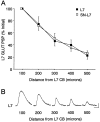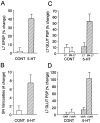Site-specific and sensory neuron-dependent increases in postsynaptic glutamate sensitivity accompany serotonin-induced long-term facilitation at Aplysia sensorimotor synapses
- PMID: 9185535
- PMCID: PMC6573320
- DOI: 10.1523/JNEUROSCI.17-13-04976.1997
Site-specific and sensory neuron-dependent increases in postsynaptic glutamate sensitivity accompany serotonin-induced long-term facilitation at Aplysia sensorimotor synapses
Abstract
Long-term changes in the efficacy of Aplysia sensory neuron (SN) connections accompany behavioral training or applications with 5-HT. The changes evoked by training or 5-HT include formation of new SN varicosities and transmitter release sites. Because new synapse formation requires proper alignment of presynaptic structures with postsynaptic zones containing a high density of transmitter receptors, we examined whether changes in postsynaptic sensitivity to the presumed SN transmitter (glutamate) were correlated with formation and distribution of new SN varicosities in contact with motor cell L7 in cell culture. The formation of stable SN connections after 4 d in culture did not significantly change overall responses to focal applications of glutamate. However, specific sites along L7's axon apposed to SN varicosities expressed larger responses to glutamate compared with adjacent sites with few SN varicosities. After treatments with 5-HT that evoked long-term changes in both the structure and the function of SN-L7 synaptic interaction, glutamate responses increased selectively at sites along the surface of L7's axon with preexisting or new SN varicosities. Increases in postsynaptic response to glutamate 24 hr after 5-HT treatment required interaction with an SN. These results suggest that new synapse formation between neurons, either with regeneration or after external stimuli that evoke increases in synaptic efficacy, involves site-specific changes in expression of functional neurotransmitter receptors on the postsynaptic cell that is regulated by interaction with the presynaptic neuron.
Figures








Similar articles
-
Binding of serotonin to receptors at multiple sites is required for structural plasticity accompanying long-term facilitation of Aplysia sensorimotor synapses.J Neurosci. 1998 Jun 1;18(11):3991-4000. doi: 10.1523/JNEUROSCI.18-11-03991.1998. J Neurosci. 1998. PMID: 9592080 Free PMC article.
-
Neuropeptide localization in varicosities of Aplysia sensory neurons is regulated by target and neuromodulators evoking long-term synaptic plasticity.J Neurobiol. 1996 Nov;31(3):297-308. doi: 10.1002/(SICI)1097-4695(199611)31:3<297::AID-NEU3>3.0.CO;2-5. J Neurobiol. 1996. PMID: 8910788
-
Postsynaptic regulation of the development and long-term plasticity of Aplysia sensorimotor synapses in cell culture.J Neurobiol. 1994 Jun;25(6):666-93. doi: 10.1002/neu.480250608. J Neurobiol. 1994. PMID: 8071666 Review.
-
Differential distribution of functional receptors for neuromodulators evoking short-term heterosynaptic plasticity in Aplysia sensory neurons.J Neurosci. 1996 Dec 1;16(23):7540-9. doi: 10.1523/JNEUROSCI.16-23-07540.1996. J Neurosci. 1996. PMID: 8922410 Free PMC article.
-
Structural plasticity at identified synapses during long-term memory in Aplysia.J Neurobiol. 1989 Jul;20(5):356-72. doi: 10.1002/neu.480200508. J Neurobiol. 1989. PMID: 2664078 Review.
Cited by
-
Reconsolidation of long-term memory in Aplysia.Curr Biol. 2012 Oct 9;22(19):1783-8. doi: 10.1016/j.cub.2012.07.038. Epub 2012 Aug 9. Curr Biol. 2012. PMID: 22885063 Free PMC article.
-
Dscam mediates remodeling of glutamate receptors in Aplysia during de novo and learning-related synapse formation.Neuron. 2009 Feb 26;61(4):527-40. doi: 10.1016/j.neuron.2009.01.010. Neuron. 2009. PMID: 19249274 Free PMC article.
-
Nonassociative learning in invertebrates.Cold Spring Harb Perspect Biol. 2015 Feb 26;7(5):a021675. doi: 10.1101/cshperspect.a021675. Cold Spring Harb Perspect Biol. 2015. PMID: 25722464 Free PMC article. Review.
-
Cellular, molecular, and epigenetic mechanisms in non-associative conditioning: implications for pain and memory.Neurobiol Learn Mem. 2013 Oct;105:133-50. doi: 10.1016/j.nlm.2013.06.008. Epub 2013 Jun 22. Neurobiol Learn Mem. 2013. PMID: 23796633 Free PMC article. Review.
-
Synaptic facilitation and behavioral dishabituation in Aplysia: dependence on release of Ca2+ from postsynaptic intracellular stores, postsynaptic exocytosis, and modulation of postsynaptic AMPA receptor efficacy.J Neurosci. 2005 Jun 8;25(23):5623-37. doi: 10.1523/JNEUROSCI.5305-04.2005. J Neurosci. 2005. PMID: 15944390 Free PMC article.
References
-
- Atashi JR, Klinz SG, Ingraham CA, Matten WT, Schachner M, Maness PF. Neural cell adhesion molecules modulate tyrosine phosphorylation of tubulin in nerve growth cone membranes. Neuron. 1992;8:831–842. - PubMed
-
- Bailey CH, Chen M. Morphological basis of long-term habituation and sensitization in Aplysia. Science. 1983;220:91–93. - PubMed
-
- Bailey CH, Kander ER. Structural changes accompany memory storage. Annu Rev Physiol. 1993;55:397–426. - PubMed
Publication types
MeSH terms
Substances
Grants and funding
LinkOut - more resources
Full Text Sources
